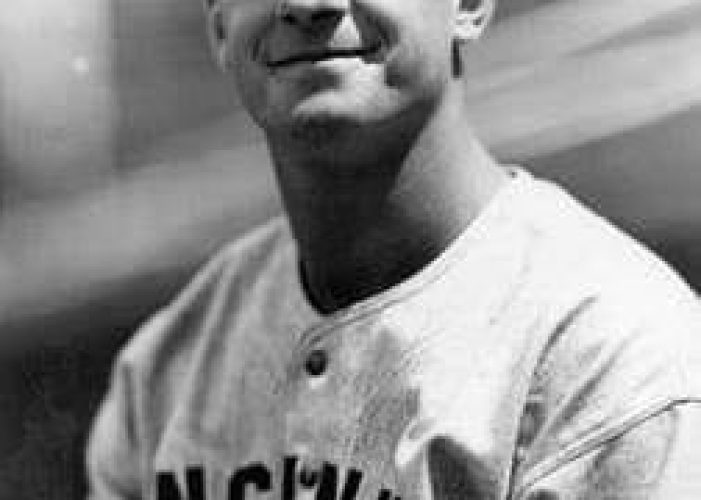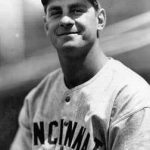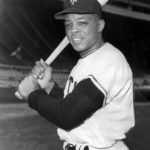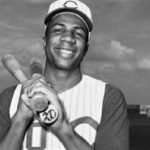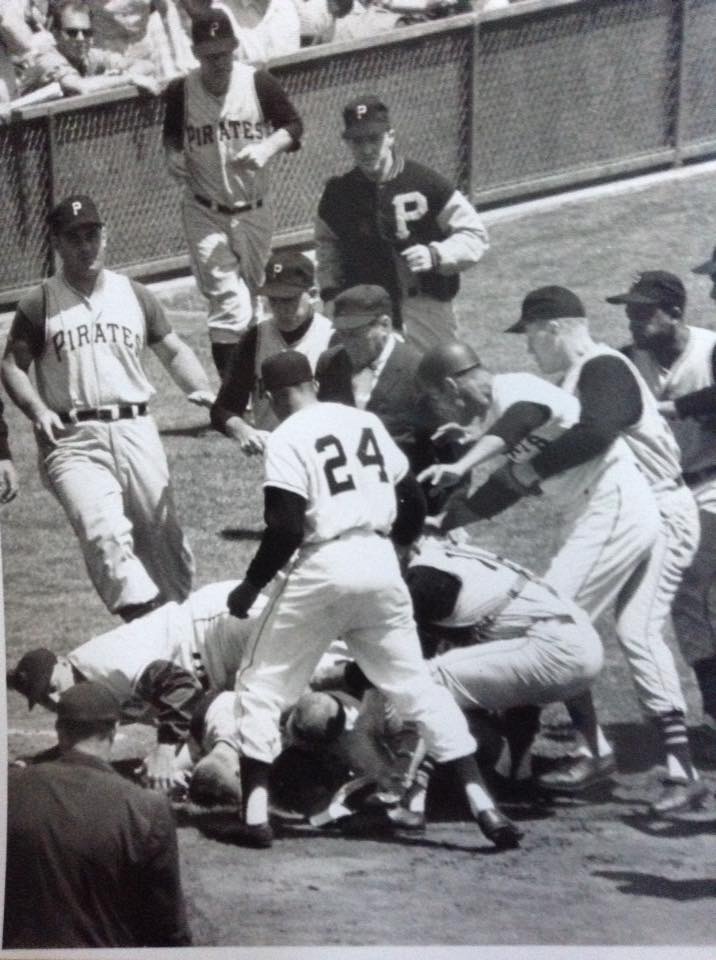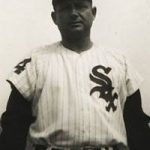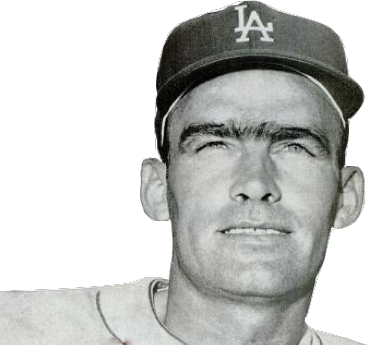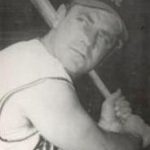Ted Kluszewski
Position: First Baseman
Bats: Left • Throws: Left
6-2, 225lb (188cm, 102kg)
Born: September 10, 1924 in Argo, IL
Died: March 29, 1988 (Aged 63) in Cincinnati, OH
Buried: Gate of Heaven Cemetery, Cincinnati, OH
High School: Argo HS (Argo, IL)
School: Indiana University Bloomington (Bloomington, IN)
Debut: April 18, 1947 (7,964th in MLB history)
vs. PIT 1 AB, 0 H, 0 HR, 0 RBI, 0 SB
Last Game: October 1, 1961
vs. CLE 1 AB, 1 H, 0 HR, 0 RBI, 0 SB
Full Name: Theodore Bernard Kluszewski
Nicknames: Big Klu
Pronunciation: \kluh-ZOO-skee\
View Player Bio from the SABR BioProject
Nine Players Who Debuted in 1947
Nellie Fox
Duke Snider
Larry Doby
Jackie Robinson
Curt Simmons
Mel Parnell
Vic Wertz
Ted Kluszewski
Ferris Fain
All-Time Teammate Team
Coming Soon
Notable Events and Chronology for Ted Kluzewski Career
Biography
One of the most powerful and intimidating hitters of the 1950s, Ted Kluszewski terrorized opposing pitchers every time he stepped into the batter’s box. His huge biceps exposed by the sleeveless uniform he wore to allow his bulging muscles room to move, the man nicknamed “Big Klu” gained general recognition as the strongest player in the game. When asked to do so, Hall of Fame manager Leo Durocher once named five of the strongest players in baseball. Pointed out to him that he failed to include Kluszewski on his list, Durocher responded, “Kluszewski? I’m talking about human beings!”
More than just a slugger, Kluszewski typically posted high batting averages while rarely striking out. He batted over .300 in seven out of eight seasons at one point, hitting no lower than .314 from 1952 to 1955. He also surpassed 40 home runs and 100 RBIs in three of those four years, coming exceptionally close on two separate occasions to becoming just the second player in baseball history to strike out fewer than 50 times while also hitting 50 home runs (Johnny Mize accomplished the feat for the Giants in 1947). Only a bad back, which reduced his playing time and offensive production his final five seasons, prevented Kluszewski from compiling even more impressive numbers than the 279 home runs, 1,028 runs batted in, and .298 batting average he posted over the course of his 15-year major league career.
Born in Argo, Illinois on September 10, 1924, Theodore Bernard Kluszewski graduated from Argo Community High School before attending Indiana University, where he played both football and baseball. A standout tight end on the Hoosier football squad, Kluszewski was discovered by the Cincinnati Reds by chance. The Reds normally held spring training in Tampa, Florida. However, due to wartime travel restrictions, they trained at Indiana University from 1943 to 1945. Reds groundskeeper Matty Schwab saw the strapping youngster hitting balls over an embankment near the baseball diamond that no other Reds player even approached. Cincinnati scouts subsequently offered Kluszewski a contract, but he chose not to sign immediately since he didn’t wish to endanger his collegiate football eligibility. Kluszewski instead signed after he graduated in 1946. He spent the next two years advancing through Cincinnati’s minor league farm system, posting batting averages of .325 and .377, before being called up by the Reds for a brief trial in 1947. In 10 pinch-hit appearances, he drove in two runs and collected his first major league hit. Kluszewski joined the Reds for good the following year, gradually establishing himself as the team’s starting first baseman over the course of the season. He finished his rookie campaign with 12 home runs, 57 runs batted in, and a .274 batting average, in just under 400 official at-bats.
In spite of his tremendous physical strength, it took Kluszewski some time to develop his power stroke. Although he batted .309 in 1949, he hit only eight home runs and knocked in just 68 runs. The massive 6’2”, 240-pound slugger appeared to be well on his way to cultivating his home-run swing the following year, when he hit 25 homers and drove in 111 runs, while batting .307, accumulating a career-high 37 doubles, and striking out only 28 times. Yet, Kluszewski had yet to reach his full potential as a power hitter since he combined to hit a total of only 29 home runs over the course of the next two seasons. Nevertheless, he finished third in the National League with a .320 batting average and a .509 slugging percentage in 1952.
It was during his first few years in Cincinnati that Kluszewski agitated the Reds front office by cutting off the sleeves of his uniform because they constricted his large biceps and shoulders, thereby interfering with his swing. Kluszewski later said, “They got pretty upset, but it was either that or change my swing – and I wasn’t about to change my swing.” Kluszewski further exposed his massive arms by electing not to wear a T-shirt underneath his uniform.
Free of all constrictions, Kluszewski began a four-year run in 1953 that established him as one of baseball’s premier sluggers. He hit 40 homers, knocked in 108 runs, scored 97 others, and batted .316 in the first of those campaigns, earning in the process his first of four consecutive All-Star nominations and a seventh-place finish in the league MVP voting. Kluszewski improved upon those numbers in 1954, leading the National League with 49 home runs and 141 runs batted in, while also placing among the leaders with 104 runs scored, a .326 batting average, 187 hits, 368 total bases, a .407 on-base percentage, and a .642 slugging percentage. The powerful first baseman struck out only 35 times, falling just one home run short of becoming only the second player in the history of the game to strike out fewer than 50 times while also hitting 50 home runs. Kluszewski’s outstanding performance earned him a second-place finish in the league MVP balloting to Willie Mays.
Kluszewski put together another exceptional year for the Reds the following season, when he again finished among the league leaders with 47 home runs, 113 runs batted in, 116 runs scored, a .314 batting average, a .382 on-base percentage, a .585 slugging percentage, and 358 total bases. He also topped the senior circuit with 192 hits and set a modern N.L. record by scoring runs in 17 straight games at one point. Kluszewski’s 47 home runs and 40 strikeouts left him just three homers short of joining Johnny Mize on the extremely exclusive list of players to surpass 50 home runs while striking out fewer than 50 times.
Kluszewski had his last big year for Cincinnati in 1956, when he helped the Reds establish a new National League home run record. Joined in the middle of the lineup by N.L. Rookie of the Year Frank Robinson, who hit 38 homers, and slugging outfielder Wally Post, who homered 36 times, Kluszewski hit 35 home runs, knocked in 102 runs, and batted .302. The powerful first baseman’s outstanding campaign concluded an exceptionally successful four-year run during which he averaged 42 home runs and 116 runs batted in.
As feared a batsman as Kluszewski became during that period, he often failed to garner as much respect as he deserved for his outstanding defense. A smooth fielder, he led all National League first basemen in fielding percentage five straight times from 1951 to 1955, establishing in the process a new major league record.
However, injuries began to take their toll on Kluszewski in 1957. Limited by a bad back to just 69 games and 127 official at-bats that year, the slugger never again played a full season in the majors. Cincinnati traded him to Pittsburgh prior to the start of the 1958 campaign, and Kluszewski spent the next season-and-a-half platooning at first with the right-handed hitting Dick Stuart, while also serving the team as a pinch-hitter. The Pirates traded Kluszewski to the Chicago White Sox in late August of 1959, and the former N.L. home run champ batted .297 for the eventual A.L. champions over the season’s final month. Although the White Sox lost the World Series to the Dodgers in six games, Kluszewski hit three home runs, knocked in 10 runs, and batted .391 during the Fall Classic.
Kluszewski spent one more year with the White Sox before being claimed by the newly-formed Los Angeles Angels when Chicago left him unprotected in the expansion draft held prior to the start of the 1961 season. Kluszewski spent the final year of his career playing in California, where he hit 15 home runs in only 263 official at-bats, despite being hampered by back and leg problems. Kluszewski announced his retirement at season’s end, subsequently staying away from the game for almost a decade before returning to the Reds as a coach from 1970 to 1978. He served the team as hitting coach under Sparky Anderson during Cincinnati’s days as The Big Red Machine, ably assisting future Hall of Famers Johnny Bench, Tony Perez, Joe Morgan, and Pete Rose. He also helped to develop the sweet swing of Ken Griffey and the power stroke of George Foster. Kluszewski became Cincinnati’s minor league hitting instructor when Anderson left the team at the conclusion of the 1978 campaign. He continued to serve the organization in that capacity until 1986, when he suffered a massive heart attack that forced him to undergo emergency bypass surgery. He retired afterward, before eventually passing away from another heart attack on March 29, 1988, at the age of 63. The Reds retired his number 18 ten years later, on July 18, 1998 before a game against the San Diego Padres at Cinergy Field.
@ET-DC@eyJkeW5hbWljIjp0cnVlLCJjb250ZW50IjoicG9zdF90YWdzIiwic2V0dGluZ3MiOnsiYmVmb3JlIjoiTGVhcm4gTW9yZSBhYm91dCB0aGUgdGVhbXMsIHBsYXllcnMsIGJhbGwgcGFya3MgYW5kIGV2ZW50cyB0aGF0IGhhcHBlbmVkIG9uIHRoaXMgZGF0ZSBpbiBoaXN0b3J5IC0gLSAtIC0gLSAtIC0gIiwiYWZ0ZXIiOiIiLCJsaW5rX3RvX3Rlcm1fcGFnZSI6Im9uIiwic2VwYXJhdG9yIjoiIHwgIiwiY2F0ZWdvcnlfdHlwZSI6InBvc3RfdGFnIn19@
Factoids, Quotes, Milestones and Odd Facts
Coming soon
Other Resources & Links
Coming Soon
If you would like to add a link or add information for player pages, please contact us here.

